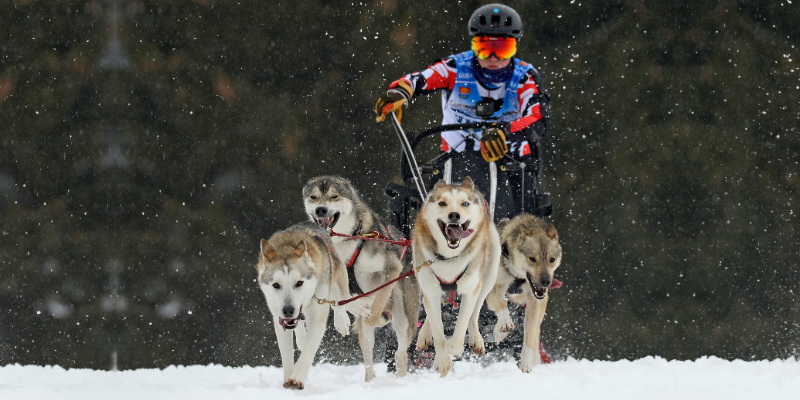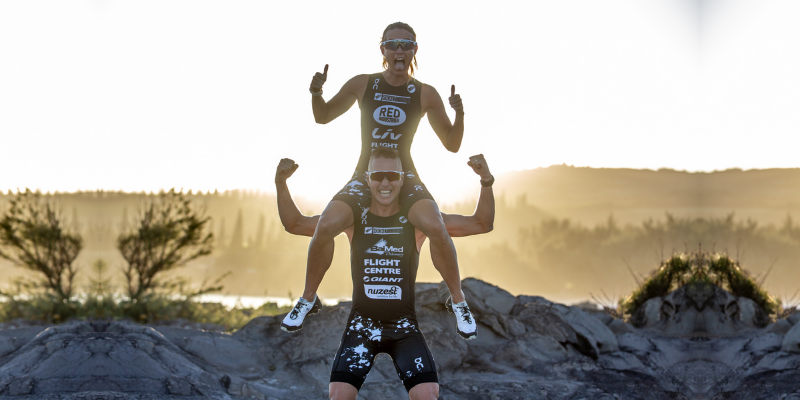“I went to Canada when I was 18, did a husky tour across a frozen lake and fell in love with the dogs. I have never looked back since.”
These are the words of Vickie Pullin, who 13 years on from this experience is ranked as the leading female sled dog racer in the UK.

Although sled dog racing is a relatively unknown sport, Vickie’s passion and commitment to training herself and her canine athletes is impressive and unwavering. She is hugely ambitious and after gaining multiple top 15 World Rankings, she continues her journey towards her ultimate goal – to become a World Champion.
What’s involved?
Sled dog racing comes in many forms, taking place both on snow and on dry land. For Vickie, her team ‘Pullin Power’ concentrates on sprint races. She explains more:
“We race sprint sled dogs, so short distances on the dryland (wheels) and also on the snow. Normally races are about 5km on the dry land and then around 10k on the snow. Our sled dogs are a mix of German Short Haired Pointers, English Short Haired Pointers, some Greyhounds and some Huskies.”

Not to be content with classic sled dog racing, Vickie explains how she likes to diversify: “As well as racing a kart with four or six dogs or a sled on the snow with four dogs, I also race in bike joering with one dog or a scooter with two dogs.”
The canine athletes
Vickie is quick to point out that her love of the sport starts with the dogs, explaining that they are the true athletes:
“Working with the dogs is my greatest love, and to be able to compete at the highest level of the sport makes me extremely proud of my team and what we have achieved. Every race I go to we make amazing memories and without all my dogs I would not be where I am today.

“It’s the bond you can build with a dog, is not like anything else I have ever experienced and working with them as a team - it’s the best team to be part of. The dogs have to want to run for you, you can’t make or force them into it, and the drive and passion they have is inspirational.”
Physical demands
As you would imagine, the sled dogs have to be in prime physical condition for racing, but the fitness and strength of the human member of the team can often be overlooked. Vickie works hard on her fitness, and she explains why:
“Sled dog racing is very physical, and it is not just a case of letting the dogs do all the work! The lighter and stronger I am, the faster the dogs can run. Like any sport every marginal gain is critical; a few years ago, I missed out on a gold medal at the World Championships by two seconds.

“My fitness is as important as the dogs and I always look at myself like the extra dog on the team - the better and faster I can ride a bike or run up hills, the more I help my dogs to make their lives easier and allow them to run faster.”
Training
Being a semi-professional athlete means Vickie has to juggle her training with work. Vickie runs experience days for the public, as well as looking after her 37 dogs! She tries to train six days a week and often has to train early in the morning (around 5am.)
Vickie’s training involves a lot of cycling and running, to complement all the different types of races she competes in. She also spends a lot of time working on leg and core strength. She explains more:
“With the classes I race in, the bike has to be the most demanding, so I try and train in a similar way to a professional cyclist. When on the sled and cart, we may have to help push or run up hills, so I do have to put some run training into my programme as well.

“Leg and core strength are vital, as well as overall cardiovascular fitness. For example, a 5km trail on a bike will be non-stop sprinting, with no place to rest other than the finish line!”
Injuries and recovery
Aside from a few crashes, Vickie has been lucky to avoid any serious injuries. “I have had some cracking bruises and cuts from falling off the sled, but we try very hard not to crash. So not to risk the dogs. Fortunately, I have not had any big injuries,” explains Vickie.
Although she has been lucky enough to avoid injury, Vickie is very aware of how she needs to look after her body, including managing muscle recovery from her gruelling schedule. Vickie explains;
“To achieve my career and life goals I need to be able to recover quickly and keep going... NuroKor has revolutionised recovery on the go."

"This is so huge for me with the lifestyle I have: being a semi professional athlete, working two jobs and looking after 37 dogs - it’s a lot in a day and recovery is vital. So, if I can do it on the go, which NuroKor allows me to do, then this can only help me as an athlete.”
Vickie uses NuroKor on different parts of her body, but mostly on her legs and more specifically her quadricep muscles which take a lot of the strain from her cycling and run training.
What’s next?
Due to the pandemic, Vickie has had more time than ever to train and experiment with new training methods for her dogs, but she has found the lack of racing hard:
“I think the dogs really have missed racing, as have I. But we have never been more motivated and are ready to get back out there as soon as we can. Fingers crossed for next winter!”

With the bit between her teeth, Vickie is ready to take on the rest of the world. As well as her ultimate goal of becoming World Champion, she expands on her other motivations:
“I really want to win a medal on the snow for Great Britain. As an athlete from a country that has no snow, both myself and my dogs are at a huge disadvantage. I want to show people anything is possible if you believe it enough – there’s just hard work between you and making that dream come true.”

With a never say never attitude and a commitment to training to match, it wouldn’t be surprising if we see Vickie on the top of the World Championship podium in years to come – along with her dogs of course!
To find out more about Vickie and her team, Pullin Power visit the website or Facebook.
To learn more about experiences with sled dogs visit Arctic Quest here



